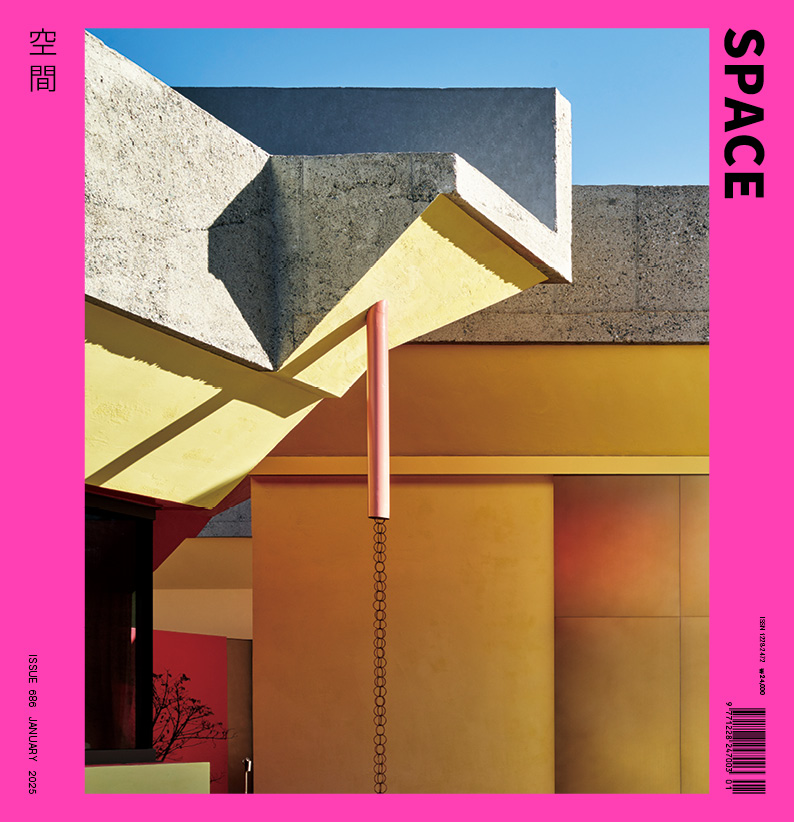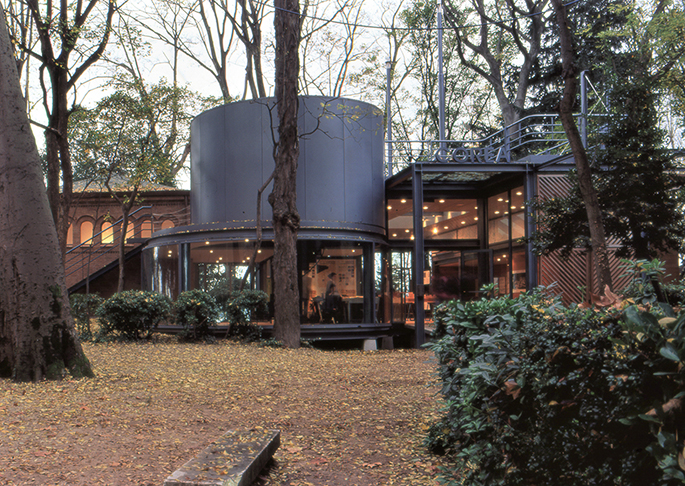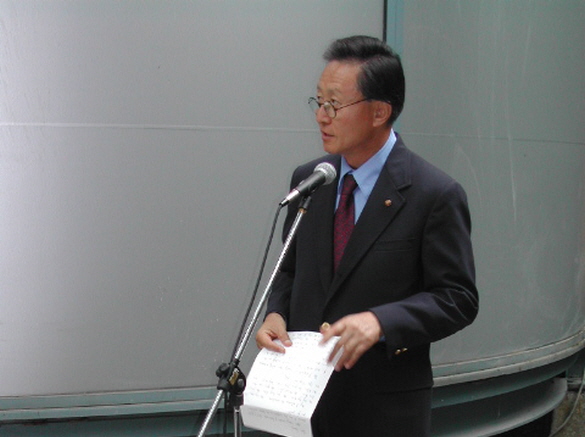SPACE January 2025 (No. 686)
SPACE is preparing an archival book, Archiving International Architecture Exhibition at the Korean Pavilion at the Venice Biennale 1996 – 2025 (tentative title), as part of the ‘30th Anniversary Archival Research of the Korean Pavilion at the Venice Biennale’, organised by the Arts Council Korea (ARKO). The archive book, scheduled to be published in May 2025, will include interviews with the commissioners of the early exhibitions at the Korean Pavilion, and will be published in a series of SPACE. Through these interviews, SPACE will reconstruct a narrative of the early years of Korean architecture exhibition history centred on the Venice Biennale and reflect on the meaning of the Korean Pavilion as it celebrates its 30th anniversary.
Date and time 4th of December 2024, 14:00 – 16:00
Location SPACE meeting room
Interview Kang Sukwon former principal, Seoul Group KA, Son Jean co-principal, ison architects × Kim Jeoungeun editor-in-chief
Participants Yeo Sunhee, Yoo Jiyeon Arts Council Korea, Bang Yukyung, Kim Bokyoung
Recording Lee Sowoon
Data collection Kim Bokyoung, Bang Yukyung, Lee Sowoon
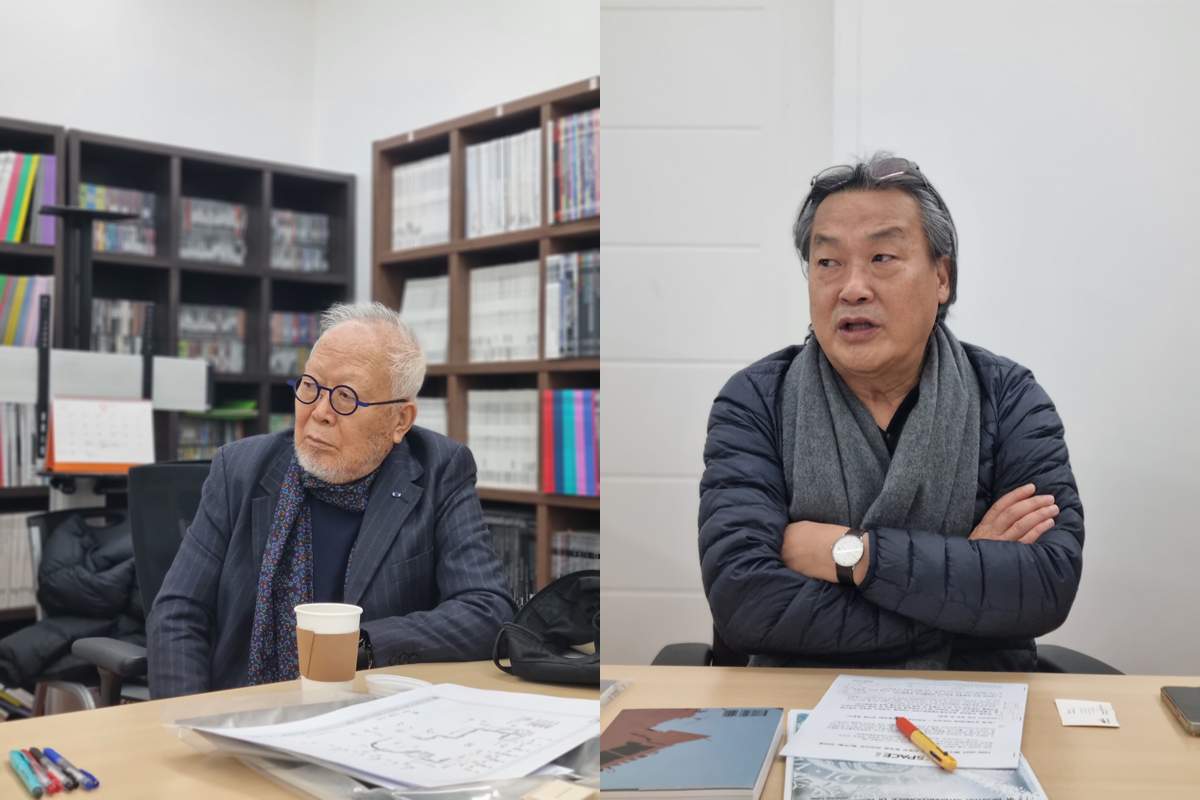
Kang Sukwon (left) and Son Jean (right) being interviewed in the SPACE meeting room on 4th of December 2024 ©Bang Yukyung
Interviews for Commissioner
The age of biennale excess. With more than 300 bienniales taking place around the world, the Korean Pavilion at the Venice Biennale is celebrating its 30th anniversary. Since its inauguration in 1995, the Korean Pavilion at the Venice Biennale, co-designed by the late Kim Seok Chul (former principal, ARCHIBAN) and Franco Mancuso (former professor, Universita Iuav di Venezia), has been an exhibition platform with a unique status in which Korean architecture meets the international stage. Despite this, it is somewhat puzzling that it is not well known to the general public in Korea, and few people within the architecture community know the details of its history. This is partly due to the fact that exhibitions in Venice have long been inaccessible, and partly due to the fact that the image of the architectural exhibition is still unclear in Korea. As some people have recently expressed fatigue or indifference to architecture biennales, it is important to ask what value we should attach to the Venice Biennale, and what the Korean Pavilion and its exhibitions have meant to us over the past 30 years.
On the occasion of the 30th anniversary of the Korean Pavilion at the Venice Biennale, SPACE is preparing an archive book documenting the 14 exhibitions of the Korean Pavilion at the Venice Biennale, from the 6th International Architecture Exhibition in 1996 to the 19th International Architecture Exhibition of Venice Biennale scheduled this year. As part of this, we will interview the earliest commissioners of the Korean Pavilion and exhibition, which are most especially lacking in documentation. Since 2015, the role of commissioner has been taken over by the Arts Council Korea (ARKO), which selects the curator, but in the early years, the commissioners, selected from within the architectural community, had to play a mixed role. The more we learnt from conducting the interviews, the more we realised that the interviews were not only an opportunity to listen to an interviewee’s voice, but also the first step in a journey to locate the people involved and the whereabouts of the many scattered materials and documents, and to put together the pieces of a large puzzle so as to better understand the situation at the time. In the interview texts, we try to be as descriptive as possible about how we acquired the material, in order to assist future research. We also recognise that interviewees may have errors in memory as they span 20 – 30 years, so we will perform a fact check and correct these manuscripts in as much detail as possible until the archive book is finalised. We have also included many personal anecdotes that would normally have been omitted, so that the reader can experience the time vividly and leave room for interpretation for researchers.
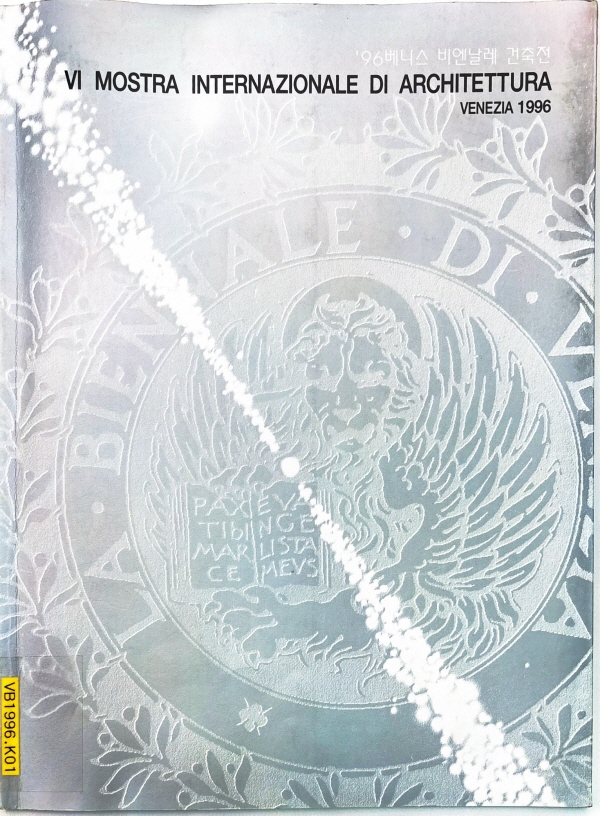
Cover of the catalogue of the Korean Pavilion at the 6th International Architecture Exhibition of Venice Biennale in 1996 (source: ARKO Arts Archive)
Background to the 6th Architecture Exhibition
The Venice Biennale was founded in 1895 by the Venice City Council to commemorate the silver wedding of the Emperor of Italy and his wife. Beginning as a section of the art exhibition in 1975, the architecture exhibition was held as the first architecture biennale separately in 1980. Since then, architecture exhibitions have been held irregularly (the second exhibition in 1983, the third in 1985, the fourth in 1988, and the fifth in 1991). The 6th Architecture Exhibition, the first architecture exhibition after the establishment of the Korean Pavilion, was originally scheduled to be held alongside the art exhibition for the 100th anniversary of the Venice Biennale in 1995, but the architecture section was postponed by one year due to venue issues. The 6th Architecture Exhibition, held from 15th of September to 17th of November 1996, was directed by Austrian architect Hans Hollein and featured the work of architectural masters in the theme pavilion titled ‘Sensing the Future – The Architect as Seismograph’. The Korean Pavilion, which made its international debut, featured 18 entries of the design competition for the redevelopment of the Myung Dong Cathedral District and the National Museum of Korea. Commissioner Kang Sukwon and 18 architect teams participated in the exhibition. written by Kim Jeoungeun editor-in-chief
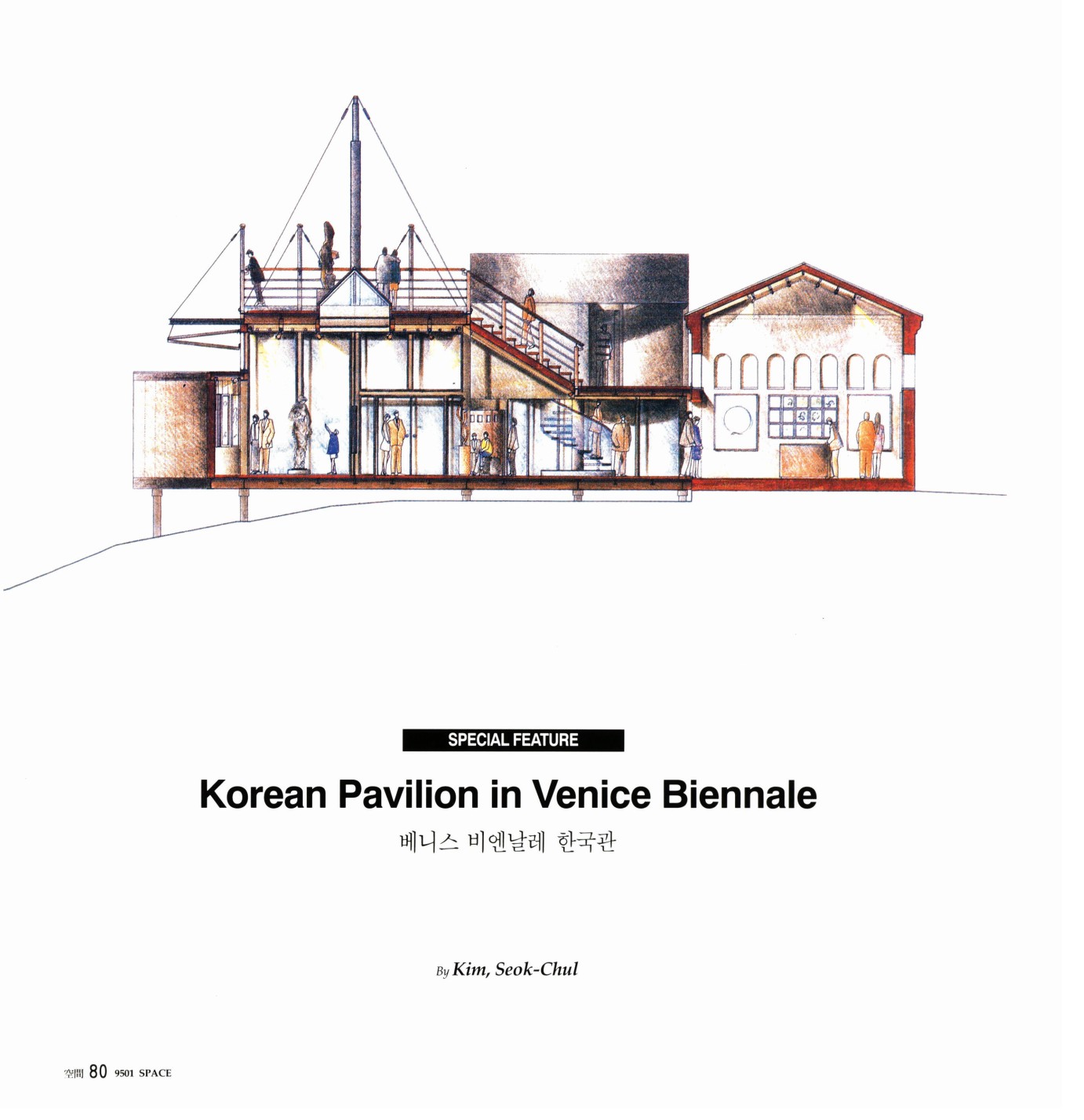
Kim Seok Chul, ‘Korean Pavilion in Venice Biennale’, SPACE No. 327 (Jan. 1995), pp. 80 – 83, 85.
Background of the Appointment of the First Commissioner
Kim Jeoungeun (Kim): Kang Sukwon was the first commissioner of the exhibition of Korean Pavilion at the 6th International Architecture Exhibition of Venice Biennale in 1996. You were the president of the Korean Institute of Architects (1996 – 1998) at the time, but I think the fact that you had worked in France for a long time and had been involved in a range of activities that introduced Korean architecture to an international audience, such as the Union Internationales des Architectes (UIA), was a major factor in your appointment. You were also involved in international exhibitions such as the Tripoli International Fair in Libya (1962) and the Korean pavilion at the Paris International Exposition (1966). What do you remember about the selection process of the commissioner?
Kang Sukwon (Kang): It was the first architecture exhibition, so it was very new to everyone. I think the Ministry of Culture and Sports asked the Korean Institute of Architects to select the commissioner.▼1
Kim: Since the Korean Pavilion designed by Kim Seok Chul was built in 1995, the art and architecture worlds began to participate in the Venice Biennale in earnest. The early process seems to have been driven by the art world rather than the architecture world. I wonder what the architecture world thought of participating in the Venice Biennale at the time.
Kang: I think our interest began in earnest after we constructed the Korean pavilion. Before that, we didn’t really think that we should participate in the Venice Biennale. The Venice Biennale was famous for art, theatre, and cinema, but only a few people know about architecture exhibition.
Son Jean (Son): That’s right, but I remember that there was a team from Korea that submitted to the Venice Biennale for the first time in 1985, and it was quite a hot topic at the time. You may know Kim Moonduck, and he, along with my classmate Hong Gunsik, applied for and won International Competition at the 3rd Architecture Exhibition.▼2 Perhaps, they were the ones who let the Korean architecture world know of the Venice Biennale. At that time, there was no Korean domestic architect who participated and won international competition held abroad. The only case is Kim Swoo Geun who applied to the International Design Competition for Centre Pompidou.▼3 I also became aware of the biennale thanks to the news.
Kim: I think at that time, the Architecture Exhibition of Venice Biennale was not globally known as it is now.
‘The International Architecture Exhibition of Venice Biennale, which started in 1980 and is celebrating its sixth anniversary this year, is still not well recognized in Korea, but it will be established by the public as an important international architecture exhibition that reflects and influences the trends of contemporary architecture in the world. In particular, from the 3rd exhibition organized by Aldo Rossi, it has expanded to be on a global scale, peaking with the postmodernist art and culture movement at the time, influencing other art and culture sectors.’ _ ‘Overview of the Venice Biennale’, Korean Pavilion catalogue, 1996, p. 4
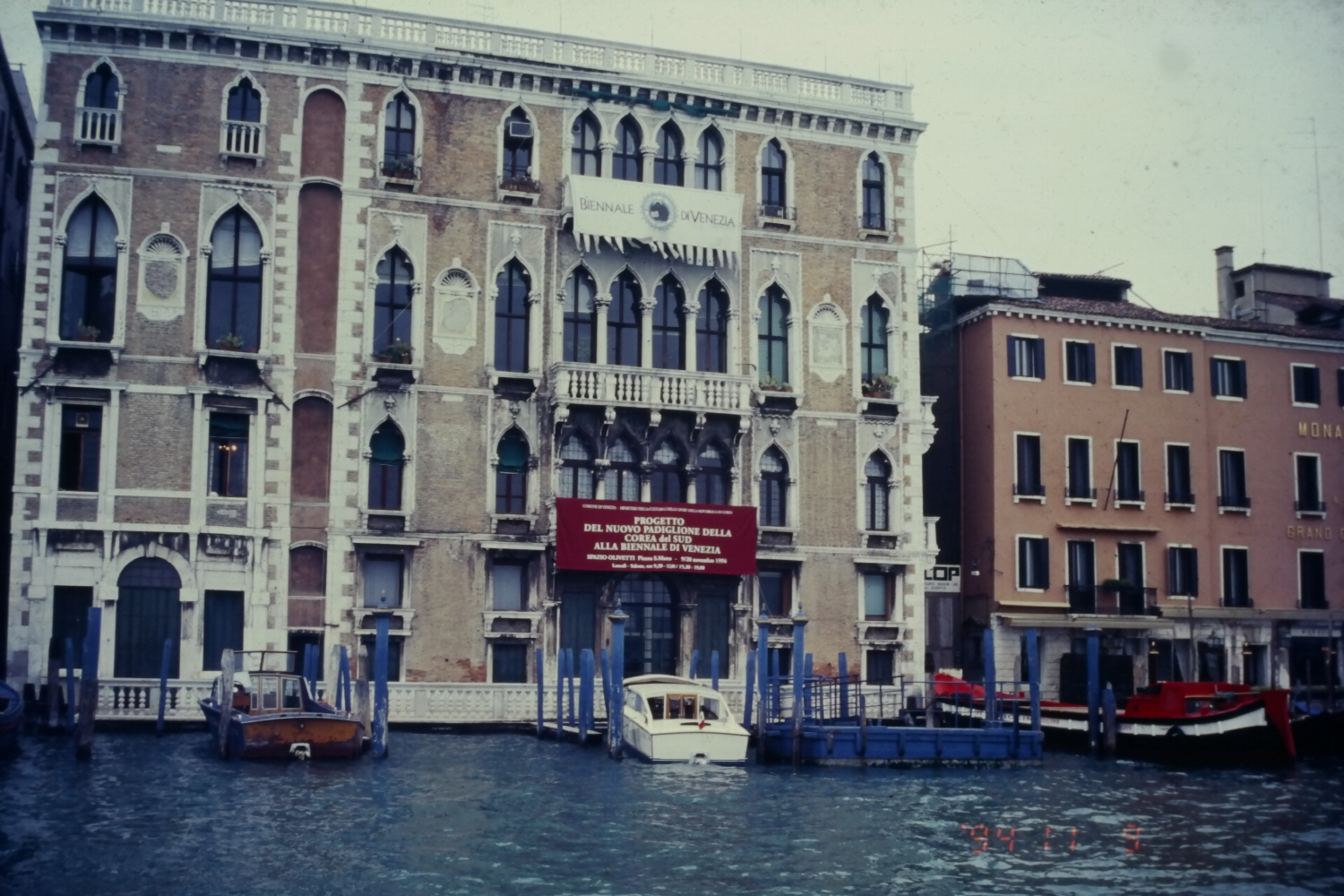
The Venice Biennale headquarters building, Ca’ Giustinian in Venice. A promotional banner for the new Korean Pavilion project exhibition is hung at the entrance. The photos on pages 120 – 123 are part of the slide films donated by Kang Sukwon, to Kim Dongjin (professor, Hongik University). ©Kang Sukwon
Son: The Art Biennale has been influential for quite a long time as part of the Venice Biennale. The 3rd Architecture Exhibition in 1985 was a turning point, and it emerged as an international event. And in Korea, it felt like something from another world, until the Korean Pavilion was built. After we secured our own pavilion, it became our job. Before the construction of Korean Pavilion, I did a part time job to help the chairman of the Art Biennale. At that time, Korea got a room in one corner of the Italian Pavilion, along with some African countries.
Kim: Tell us about your relationship with Kang Sukwon. What role did you play in the construction of the Korean Pavilion at the Venice Biennale or the Exhibition at the Korean Pavilion during the 6th Architecture Exhibition in 1996?
Son: Kang was my professor at Hongik University, but he probably can’t remember when I first took his class after I got out of the army. I became close to him because of the Venice Biennale. I went to Venice in 1987 and came back to Korea in 1996. I was in Venice during the construction of the Korean Pavilion, and I helped Kim Seok Chul a lot when he visited Venice. I always interpreted for him when he met with professor Franco Mancuso, local architect in Venice, and I worked part-time while helping people from the Ministry of Culture and Sports who often visited Venice. So, naturally, I was involved in the construction of the Korean Pavilion from the beginning, and then Kang Sukwon came as a commissioner. I accompanied him to almost every meeting he attended, and after the meeting, we would have drinks together. (laugh)
Kang: Son played his role as more of a member than an interpreter, as the other members were in Korea.
Kim: The Korean Pavilion catalogue shows that the expert committee members were Kim Kyongsoo (then professor, Myongji University), Kim Moonduck (then professor, department of interior design at Konkuk University), and Choi Wook (then principal, K&C Architecture). What role did they actually play?
Kang: They gave us their opinions and helped us to form our own. When it came to the visit to Venice, they couldn’t help us on site because we couldn’t afford it financially at that time, but Son helped me a lot. I remember that Venice is very humid, so if we put something on the exhibition room, it would often come off the wall on the next day, and that was a big problem for us.
Kim: Since 2015, ARKO played the role of commissioner, and the curator is selected from the architectural community. However, in 1994 – 1996, it was the first time Korea participated in an architecture exhibition, I think the exhibition promotion system and the role of the commissioner was not clearly established. The Korean Pavilion catalogue states ‘Korea’s participation in the Venice Biennale is organised by a commissioner recommended by the Korean Institute of Architects, with the cooperation of the Ministry of Culture and Sports and the support of the Korean Culture and Arts Foundation’. Korea’s participation in the Art Biennale had a short history; only three times of participation before the opening of the Korean Pavilion, and the art exhibition in the Korean Pavilion since 1995. However, it is difficult to compare the art world which has a lot of exhibition experience with the architecture world, and it was probably the first time for Korean architects to serve as commissioners in the international exhibition. What kind of role were you asked to play as a commissioner at the time, or what did you think of your role?
Kang: To put it simply, a commissioner is like an ambassador, promoting Korean issues and having a lot of meetings with people from other countries. Since it was the first time, and it was the first architecture exhibition after the Korean Pavilion was established, I thought I should promote Korean architecture.
_
1 On 25th of November 1994, the Korean Institute of Architects (Yoon Seungjoong, president) sent a letter to the Minister of Culture and Sports requesting approval of the appointment of Kang Sukwon, then vice president of the institute, as a commissioner.
2 In 1985, the 3rd Architecture Exhibition was organised by Aldo Rossi and an international design competition was held under the title of ‘Venice Plan’ for 10 sites around Venice, and more than 500 works were submitted. In Korea, the team of Kim Moonduck, Seo Byunggun, and Hong Gunsik participated and won the prize for their plan to renovate Romeo and Juliet Castle. Korean Institute of Architects, ‘News: Vice President Kang Sukwon Selected as First Venice Biennale Commissioner’, Architect, No. 309 (Jan. 1995).
3 The design competition for the Beaubourg Center, also known as the Centre Pompidou, was held in February 1971 as an international design competition open to architects from all over the world. Korean architects who participated in the competition included Kim Swoo Geun, Kang Sukwon, and Kimm Jongsoung. Park Junghyun, ‘Stacked Spaces: Plateau Beaubourg Art Center Plan’, SPACE No. 639 (Feb. 2021), pp. 126 – 131.
...
